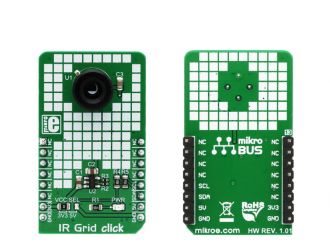
We strongly encourage users to use Package manager for sharing their code on Libstock website, because it boosts your efficiency and leaves the end user with no room for error. [more info]

Rating:
Author: MIKROE
Last Updated: 2018-07-03
Package Version: 1.0.0.1
mikroSDK Library: 1.0.0.0
Category: Optical
Downloaded: 7758 times
Not followed.
License: MIT license
IR Grid click is a thermal imaging sensor. It has an array of 64 very sensitive factory calibrated IR elements (pixels), arranged in 4 rows of 16 pixels, each measuring an object temperature up to 300ËšC within its local Field of View (FOV).
Do you want to subscribe in order to receive notifications regarding "IR Grid click" changes.
Do you want to unsubscribe in order to stop receiving notifications regarding "IR Grid click" changes.
Do you want to report abuse regarding "IR Grid click".


Library Description
Library performs IR and temperature measurement. The sensor gets an IR picture of the detected object (body) and measures ambient temperature, compares that two measurements and shows the IR picture as a 16x4 matrix. For more details check the documentation.
Key functions:
float irgrid_getTemperature(uint16_t ptat_data, uint16_t config_reg) - Returns value of ambient temperature.void irgrid_getIRArray(uint16_t *pixel_data) - Functions for reading IR pixels.void irgrid_measurement(uint8_t *Temperature) - Functions for reading all pixels temperature.Example description
The application is composed of three sections:
void applicationTask()
{
irgrid_measurement(Temperature);
mikrobus_logWrite("IR Grid Temperature matrix",_LOG_LINE);
for (irgrid_cnt = 0; irgrid_cnt < 64; irgrid_cnt++)
{
if(irgrid_cnt % 16 == 0)
{
mikrobus_logWrite(" ",_LOG_LINE);
}
if(Temperature[ irgrid_cnt ] < 36)
{
mikrobus_logWrite("/",_LOG_BYTE);
}
else
{
mikrobus_logWrite("*",_LOG_BYTE);
}
Delay_10ms();
}
mikrobus_logWrite(" ",_LOG_LINE);
Delay_ms(3000);
}
Other MikroElektronika libraries used in the example:
Additional notes and information
Depending on the development board you are using, you may need USB UART click, USB UART 2 click or RS232 click to connect to your PC, for development systems with no UART to USB interface available on the board. The terminal available in all MikroElektronika compilers, or any other terminal application of your choice, can be used to read the message.